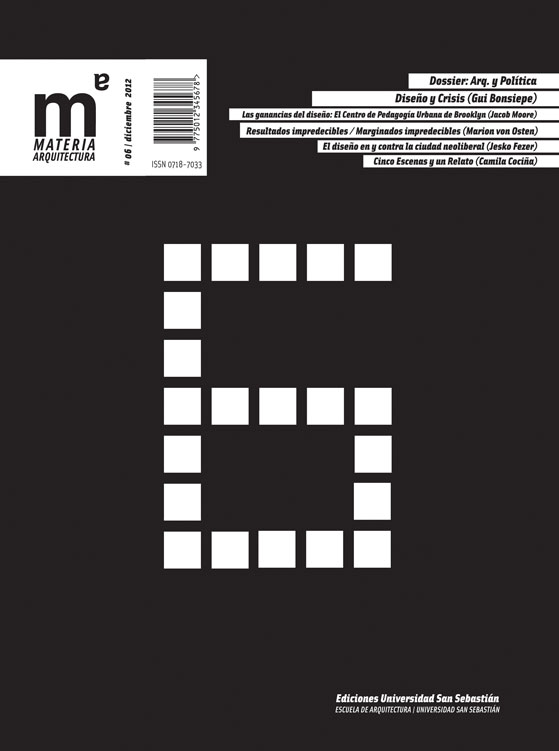Five scenes and a story: deepening democracy in the city of consensus
Article Sidebar
Keywords:
Main Article Content
Abstract
First, the “city as a conversation space”. The second one is about the asymmetries and “power” structures that are the frame of those conversation; such asymmetries imply the emergence of “conflicts” as a synonym of “democracy”, which are the third and fourth scenes. The fifth scene emerges from a society attached to order and resistant to dissent, where the “cities” face the challenge of embracing social changes, and at the same time transform themselves to support the process of democratic deepening.
Article Details
Materia Arquitectura provides immediate and free access to all the content of this online edition, published simultaneously with the print edition.
Materia Arquitectura does not charge authors for any concept.
All contents of this electronic edition are distributed under the Creative Commons license of "Attribución-shareAlike 4.0 Internacional" (CC-BY-SA).
The rights of the published texts and images belong to their authors, who grant Materia Arquitectura the license for their use. The management of the permits and the authorization of the publication of the images (or of any material) that contains copyright and its consequent rights of reproduction in this publication is the sole responsibility of the authors of the articles.
As long as they mention their origin, the authors are free to distribute their articles by other means. Any total or partial reproduction of the material must mention its origin.
Downloads
References
CASTELLS, Manuel (2011). Communication Power. Oxford/ Nueva York: Oxford University Press.
CORNWALL, Andrea (2003). “Whose Voices? Whose Choices? Reflections on Gender and Participatory Development”. World Development Vol. 31 (nº. 8), págs.1325-1342.
FAINSTEIN, Susan (1999). "Can We Make the Cities We Want?" En BEAUREGARD, Robert y BODY-GENDROT, Sophie. (eds.). The Urban Moment: Cosmopolitan Essays on the late 20th Century City. Londres: Sage.
FAINSTEIN, Susan (2005). “Planning Theory and the City”. Journal of Planning Education and Research Vol. 25 (nº. 2).
HARVEY, David (2003). “The right to the city”. International Journal of Urban and Regional Research Vol. 27 (nº. 4), págs. 939–941.
LATOUR, Bruno (2005). Reassembling the Social: An Introduction to Actor-Network Theory. Oxford: Oxford University Press.
LECHNER, Norbert (2002). Las sombras del mañana: La dimensión subjetiva de la política. Santiago: Lom.
LEFEBVRE, Henri (1996). Writings on Cities. Oxford: Blackwell.
MADANIPOUR, Ali (2007). “Social exclusion and space”, En LEGATES, Richard y STOUT, Frederic (eds). The City Reader. Londres: Routledge.
MIESSEN, Markus (2010). The Nightmare of Participation (Crossbench Praxis as a Mode of Criticality). Berlin: Sternberg.
PROGRAMA DE LAS NACIONES UNIDAS PARA EL DESARROLLO (2004). Desarrollo humano en Chile 2002, Vol. 1. Santiago: Lom.
RIOS, Michael (2008). “Envisioning Citizenship: Toward a Polity Approach in Urban Design”. Journal of Urban Design Vol. 13 (nº. 2), págs. 213-229.
SANDERCOCK, Leonie. (2003) “City Songlines. A planning imagination for the 21st Centruy”, En SANDERCOCK, Leonie. Cosmopolis II: Mongrel cities in the 21st
Century. Londres, Nueva York: Continuum.
SWYNGEDOUW, Eric (2011). Designing the Post-Political City and the Insurgent Polis. Londres: Bedford.
Most read articles by the same author(s)
- Camila Cociña, Cinco escenas y un relato: profundización democrática en la ciudad de los consensos , Materia Arquitectura: No. 06 (2012): Materia Arquitectura 06 (Diciembre/December 2012)
